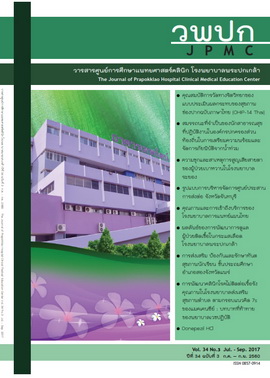ผลลัพธ์ของการพัฒนาการดูแลผู้ป่วยติดเชื้อในกระแสเลือด โรงพยาบาลพระปกเกล้า
Main Article Content
Abstract
ที่มาของปัญหา: สาเหตุสำคัญของการเสียชีวิตของผู้ป่วยติดเชื้อในกระแสเลือด ได้แก่ การได้รับการวินิจฉัยที่ล่าช้า เริ่มให้ยาปฏิชีวนะช้ากว่า 3 ชั่วโมงหลังการวินิจฉัย หรือให้ยาปฏิชีวนะที่ไม่ครอบคลุมเชื้อภายในระยะเวลาที่เหมาะสม และการเข้ารับการรักษาเมื่อมีอาการของโรครุนแรง ทำให้เกิดอวัยวะล้มเหลวหลายระบบตามมา ส่งผลให้อัตราการเสียชีวิตสูงขึ้น
วัตถุประสงค์: เพื่อพัฒนาแนวปฏิบัติการพยาบาล, ศึกษาผลลัพธ์และความพึงพอใจของพยาบาลวิชาชีพในการดูแลผู้ป่วยติดเชื้อในกระแสเลือดของโรงพยาบาลพระปกเกล้า
วัสดุและวิธีการ: การวิจัยครั้งนี้เป็นการวิจัยและพัฒนา ประกอบด้วย 4 ระยะ ดังนี้ ระยะที่ 1 วิเคราะห์สถานการณ์ก่อนพัฒนา ระยะที่ 2 พัฒนาแนวปฏิบัติการพยาบาลผู้ป่วยติดเชื้อในกระแสเลือด ตามกรอบแนวคิดของการพัฒนาแนวปฏิบัติทางคลินิกของสภาวิจัยการแพทย์และสุขภาพแห่งชาติประเทศออสเตรเลีย (NHMRC,1999) 8 ขั้นตอน และนำไปทดลองใช้ ระยะที่ 3 นำแนวปฏิบัติการพยาบาลไปใช้ในการปฏิบัติการพยาบาลโดยใช้รูปแบบการจัดการรายกรณี และระยะที่ 4 การประเมินผลลัพธ์ กลุ่มตัวอย่าง คือ ผู้ป่วยติดเชื้อในกระแสเลือดที่เข้ารับการรักษาในโรงพยาบาลพระปกเกล้าและพยาบาลวิชาชีพ ศึกษาระหว่างเดือนตุลาคม พ.ศ. 2557 ถึงเดือนกรกฎาคม พ.ศ. 2559 รวบรวมข้อมูลโดยใช้แบบบันทึกข้อมูลผู้ป่วย แบบประเมินการปฏิบัติตามแนวปฏิบัติการพยาบาล และแบบสอบถามความพึงพอใจ วิเคราะห์ข้อมูลโดยการแจกแจงความถี่ ร้อยละ และการวิเคราะห์ข้อมูลผลลัพธ์ทางคลินิกและผลลัพธ์ทางการพยาบาล โดยใช้โปรแกรมคอมพิวเตอร์ SPSS
ผลการศึกษา: วิเคราะห์สถานการณ์ในระยะที่1 พบว่า ขาดความเชื่อมโยงของทีมการรักษาพยาบาล พยาบาลจบใหม่และประสบการณ์น้อย รายงานอาการแพทย์ไม่ทันเวลา มีผลทำให้ผู้ป่วยติดเชื้อในกระแสเลือดได้รับการรักษาล่าช้า ในระยะที่ 2 ทีมได้พัฒนาแนวปฏิบัติการพยาบาลการดูแลผู้ป่วยติดเชื้อในกระแสเลือด และนำไปใช้ในการดูแลผู้ป่วยติดเชื้อในกระแสเลือดร่วมกับรูปแบบการจัดการรายกรณีในระยะที่ 3 และในระยะที่ 4 มีการประเมินผลลัพธ์จากการพัฒนาประกอบด้วย 1) ผลลัพธ์ทางคลินิกพบว่าอัตราผู้ป่วยติดเชื้อในกระแสเลือดได้รับการรักษาภายใน 6 ชั่วโมง อัตราผู้ป่วยติดเชื้อในกระแสเลือดได้รับยาปฏิชีวนะภายใน 1 ชั่วโมงและอัตราผู้ป่วยที่มีค่าเฉลี่ยความดันโลหิต ≥65 มิลลิเมตรปรอทเพิ่มขึ้น 2) ผลลัพธ์ทางการพยาบาล พบว่า อัตราความสำเร็จในการคัดกรองผู้ป่วยติดเชื้อในกระแสเลือดร้อยละ 87.5 พยาบาลวิชาชีพมีสมรรถนะในการดูแลผู้ป่วยติดเชื้อในกระแสเลือด ร้อยละ 84.84 ผู้ป่วยติดเชื้อในกระแสเลือดได้รับการประเมินและรายงานแพทย์ทันเวลา ร้อยละ 97.5 และ 3) พยาบาลวิชาชีพพึงพอใจต่อการใช้แนวปฏิบัติการพยาบาลผู้ป่วยติดเชื้อในกระแสเลือดอยู่ในระดับมาก (=3.80, SD=0.62)
สรุป: การพัฒนาแนวปฏิบัติการพยาบาลร่วมกับรูปแบบการจัดการรายกรณีในโรงพยาบาลพระปกเกล้า ทำให้ผู้ป่วยติดเชื้อในกระแสเลือดได้รับคัดกรองวินิจฉัยและได้รับการตรวจรักษาที่รวดเร็ว เกิดผลลัพธ์การดูแลที่ดีขึ้น
The Outcomes of the Development of the Patients with Septicemia,Prapokklao Hospital
Background: The main cause of death in patients with septicemia such as the late to diagnosis, starting antibiotic treatment late to more than 3 hours after diagnosis or receive to antibiotics not covering for infections and admitted in the hospital when the symptoms had more severity. Therefore, the multiple organ failure occurred, then mortality rate in patients with septicemia increased.
Objectives: To develop the nursing practice guideline, determine the outcomes of caring and the satisfaction of registered nurses for the patients with septicemia in Prapokklao hospital.
Materials and method: This research and development composed of 4 phases as follows: situation analysis in phase 1, development of the nursing practice guideline for caring of the patients with septicemia following 8 steps of the methods outlined by the Australian National Health and Medical Research (NHMRC,1999) in phase 2 , implement of nursing practice guideline by using case management model in phase 3 and outcome evaluation, the sample was 80 septicemia patients and 99 registered nurses in phase 4. The study was conducted during October 2014-July 2016. The data were collected using the patient record form, the evaluation of practice form and the satisfaction with nursing guideline questionnaire. The data were analyzed using frequency, percentage, and the analysis of measured clinical outcomes and nursing outcomes in computer program SPSS.
Results: The results were presented in four phases. Three key issues found in Phase I were a lack of nursing care team collaboration, nurses who were newly graduates and low caring experience, and delayed sign and symptom reports leading to delayed treatment for patients with septicemia. For the evaluation phase, the outcomes of the nursing practice guideline were measured in two parts including the clinical outcomes and nursing outcomes. For the clinical outcomes, the results revealed that the increased rates of patients with septicemia receiving the treatment within six hours, receiving the treatment within an hour, and having the Mean Aterial Blood Pressure ≥65 mmHg were found. In terms of nursing outcomes, the results revealed that the early warning sign screening was 87.50 percent
Conclusion: The development of care by using nursing practice guideline along with case management will be helpful for assessment, diagnosis and rapid healing to improve both clinical and nursing outcomes.
